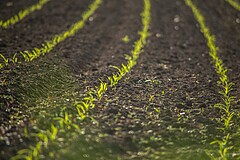Effective nature conservation strategies for the expansion of cropland - New publication by Franziska Schünemann [05.09.24]
Food, feed, fibres and bioenergy: the demand for agricultural raw materials is increasing. How can the profit-orientated expansion of cultivation areas and a effective nature conservation be reconciled? Franziska Schünemann, Head of the Chair of Bioeconomy at the University of Hohenheim, has developed a model for land use together with researchers from LMU Munich and the University of Basel. The results of their study are now published in ‘Nature Sustainability’.
The expansion of agriculture is the world's biggest contributor to greenhouse gas emissions, deforestation and the loss of natural habitats and biodiversity. An interdisciplinary team of researchers with Professor Franziska Schünemann has now analysed which regions of the world will be most affected by the future expansion of agriculture. The team developed an integrative land use model that identifies the most profitable areas worldwide for possible future agricultural expansion. Both economic and agro-ecological criteria were taken into account and the economic and ecological effects of land use change were evaluated.
An expansion of global agricultural areas by 3.6 per cent by 2030 (as expected by the FAO and OECD) would increase global agricultural production by 2 per cent, but the associated land use changes would emit around 17 gigatonnes of CO2 in the long term (almost half of current annual CO2 emissions worldwide) and lead to a 26 per cent decline in biodiversity in the affected areas.
The research team also analysed the effects of global nature conservation policy and the resulting consequences. In the context of the Kunming-Montreal Biodiversity Convention, which aims to protect 30 per cent of the global land area by 2030, the question is, which areas should be prioritised for protection. The study makes a valuable contribution here by identifying regions that will be particularly threatened in the future and highlighting the potential impact on the economy and environment. Protected areas can be planned in such a way that they combine as many goals as possible, such as climate and biodiversity protection, while at the same time taking economic interests into account. Based on the results, the effectiveness of nature conservation strategies can be improved and agricultural production can be better harmonised with environmental protection.




